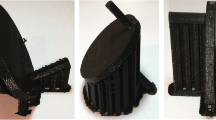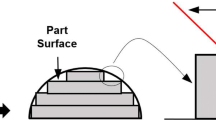Abstract
Build orientation is one of the most important process planning tasks in additive manufacturing (AM) since it directly affects the part quality, build time, cost etc. Many researchers have investigated the orientation optimization problem and proposed numerous solutions. However, former researches only focused on how to find an optimal orientation for one part, but none of the solutions was provided to solve the orientation optimization problem of Multi-part production, where a group of parts in the same build vat or chamber should be optimally-orientated simultaneously. This paper introduces a two-step solution to solve the problem. At first, a feature based method is used to generate a set of finite optimal alternative orientations for each part within a given part group to guarantee each part’s individual build quality; then an improved genetic algorithm is applied to search for an optimal combination of part build orientations to minimize the total build time and cost at a global optimal level. A case study of orientating 16 parts simultaneously within a given build chamber is presented for demonstration.












Similar content being viewed by others
References
Ahn, D., Kim, H., & Lee, S. (2007). Fabrication direction optimization to minimize post-machining in layered manufacturing. International Journal of Machine Tools and Manufacture, 47(3), 593–606.
Alexander, P., Allen, S., & Dutta, D. (1998). Part orientation and build cost determination in layered manufacturing, Computer-Aided Design. Computer-Aided Design, 30(5), 343–356.
Allen, S., & Dutta, D. (1994). On the computation of part orientation using support structures in layered manufacturing. In Solid Freeform Fabrication Symposium 1994 (pp. 259–269). Austin: University of Texas.
Byun, H. S., & Lee, K. H. (2004). A decision support system for the selection of a rapid prototyping process using the modified TOPSIS method. The International Journal of Advanced Manufacturing Technology, 26(11–12), 1338–1347.
Byun, H. S., & Lee, K. H. (2006). Determination of the optimal build direction for different rapid prototyping processes using multi-criterion decision making. Robotics and Computer-Integrated Manufacturing, 22(1), 69–80.
Canellidis, V., Giannatsis, J., & Dedoussis, V. (2009). Genetic-algorithm-based multi-objective optimization of the build orientation in stereolithography. The International Journal of Advanced Manufacturing Technology, 45(7–8), 714–730.
Cheng, W., Fuh, J. Y. H., Nee, A. Y. C., Wong, Y. S., Loh, H. T., & Miyazawa, T. (1995). Multi-objective optimization of part-building orientation in stereolithography. Rapid Prototyping Journal, 1(4), 12–23.
Danjou, S., & Köhler, P. (2009). Determination of optimal build direction for different rapid prototyping applications. In Proceedings of the 14th European Forum on Rapid Prototyping.
Deb, K., Sundar, J., Udaya, B., et al. (2006). Reference point based multi-objective optimization using evolutionary algorithms. International Journal of Computational Intelligence Research, 2(3), 273–286.
Frank, D., & Fadel, G. (1995). Expert system-based selection of the preferred direction of build for rapid prototyping processes. Journal of Intelligent Manufacturing, 6(5), 339–345.
Hiremath, N. C., Sahu, S., & Tiwari, M. K. (2013). Multi objective outbound logistics network design for a manufacturing supply chain. Journal of Intelligent Manufacturing, 24(6), 1071–1084.
Ishibuchi, H., Tsukamoto, N., & Nojima, Y., (2008). Evolutionary many-objective optimization: A short review. In Conference on Evolutionary Computation, 2008. CEC 2008 (IEEE World Congress on Computational Intelligence), June 2008, pp. 2419–2426.
Jamali, A., Khaleghi, E., Gholaminezhad, I., Nariman-Zadeh, N., Gholaminia, B., & Jamal-Omidi, A. (2014). Multi-objective genetic programming approach for robust modeling of complex manufacturing processes having probabilistic uncertainty in experimental data. Journal of Intelligent Manufacturing. doi:10.1007/s10845-014-0967-7.
Kruth, J. P., Leu, M. C., & Nakagawa, T. (1998). Progress in additive manufacturing and rapid prototyping. CIRP Annals-Manufacturing Technology, 47(2), 525–540.
Kulkarni, P., Marsan, A., & D.Dutta, D. (2000). A review of process planning techniques in layered manufacturing. Rapid Prototyping Journal, 6(1), 18–35.
Levy, G. N., Schindel, R., & Kruth, J. P. (2003). Rapid manufacturing and rapid tooling with layer manufacturing (LM) technologies, state of the art and future perspectives. CIRP Annals-Manufacturing Technology, 52(2), 589–609.
Li, S., Liu, Y., Li, Y., Landers, R. G., & Tang, L. (2013). Process planning optimization for parallel drilling of blind holes using a two phase genetic algorithm. Journal of Intelligent Manufacturing, 24(4), 791–804.
Marler, R. T., & Arora, J. S. (2004). Survey of multi-objective optimization methods for engineering. Structural and multidisciplinary optimization, 26(6), 369–395.
Masood, S. H., Rattanawong, W., & Iovenitti, P. (2003). A generic algorithm for part orientation system for complex parts in rapid prototyping. Journal of Material Processing Technology, 139(1–3), 110–116.
Mohanty, C. P., Mahapatra, S. S., & Singh, M. R. (2014). A particle swarm approach for multi-objective optimization of electrical discharge machining process. Journal of Intelligent Manufacturing. doi:10.1007/s10845-014-0942-3.
Onuh, S. O., & Yusuf, Y. Y. (1999). Rapid prototyping technology: Applications and benefits for rapid product development. Journal of intelligent manufacturing, 10(3–4), 301–311.
Padhye, N., & Deb, K. (2011). Multi-objective optimisation and multi-criteria decision making in SLS using evolutionary approaches. Rapid Prototyping Journal, 17(6), 458–478.
Pandey, P. M., VenkataReddy, N., & Dhande, S. G. (2007). Part deposition orientation studies in layered manufacturing. Journal of materials processing technology, 185(1), 125–131.
Pham, D. T., & Demov, S. S. (2001). Rapid Manufacturing: The Technologies and Applications of Rapid Prototyping and Rapid Tooling. London: Springer-Verlag.
Triki, H., Mellouli, A., & Masmoudi, F. (2014). A multi-objective genetic algorithm for assembly line resource assignment and balancing problem of type 2 (ALRABP-2). Journal of Intelligent Manufacturing. doi:10.1007/s10845-014-0984-6.
Vincent, T. L., & Grantham, W. J. (1981). Optimality in parametric systems. New York: Wiley.
Wohlers, T. (2014). Wohlers report 2013. USA: Wohlers association.
Zhang, J., & Li, Y. (2013). A unit sphere discretization and search approach to optimize building direction with minimized volumetric error for rapid prototyping. The International Journal of Advanced Manufacturing Technology, 67(1–4), 733–743.
Zhang, Y., & Bernard, A. (2013a). Using AM feature and Multi-attribute decision making to orientate part in additive manufacturing. In High value manufacturing: Advanced research in virtual and rapid prototyping. Proceedings of the 6th International Conference on Advanced Research in Virtual and Rapid Prototyping (pp. 411–416), Leiria, Portugal, 1–5 Oct 2013. CRC Press.
Zhang, Y., & Bernard, A. (2013b). Generic build time estimation model for parts produced by SLS. In High value manufacturing: Advanced research in virtual and rapid prototyping. Proceedings of the 6th International Conference on Advanced Research in Virtual and Rapid Prototyping (pp. 43–48), Leiria, Portugal, 1–5 Oct 2013. CRC Press.
Zhang, Y., & Bernard, A. (2014a). Grouping Parts for Multiple Parts Production in Additive Manufacturing. Procedia CIRP, 17, 308–313.
Zhang, Y., & Bernard, A. (2014b). An integrated decision-making model for multi-attributes decision-making (MADM) problems in additive manufacturing process planning. Rapid Prototyping Journal, 20(5), 377–389.
Zhang, Y. & Bernard, A., (2014c). AM Feature and Knowledge Based Process Planning for Additive Manufacturing in Multiple Parts Production Context, In Proceedings of 25th Annual International Solid Freeform Fabrication Symposium, pp. 1259–1276.
Zhao, J., (2005). Determination of optimal build orientation based on satisfactory degree theory for RPT. In Computer Aided Design and Computer Graphics, 2005. Ninth International Conference on IEEE, p. 6.
Author information
Authors and Affiliations
Corresponding author
Rights and permissions
About this article
Cite this article
Zhang, Y., Bernard, A., Harik, R. et al. Build orientation optimization for multi-part production in additive manufacturing. J Intell Manuf 28, 1393–1407 (2017). https://doi.org/10.1007/s10845-015-1057-1
Received:
Accepted:
Published:
Issue Date:
DOI: https://doi.org/10.1007/s10845-015-1057-1




